500 accounts payable 139 Study guides, Class notes & Summaries
Looking for the best study guides, study notes and summaries about 500 accounts payable 139? On this page you'll find 46 study documents about 500 accounts payable 139.
Page 4 out of 46 results
Sort by
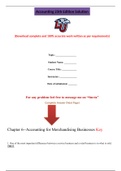
-
Chapter 6--Accounting for M.docx
- Exam (elaborations) • 77 pages • 2020
-
- $9.49
- + learn more
Chapter 6--Accounting for Merchandising Businesses Student: ___________________________________________________________________________ 1. One of the most important differences between a service business and a retail business is in what is sold. True False 2. In a merchandise business, sales minus operating expenses equals net income. True False 3. Cost of merchandise sold is the amount that the merchandising company pays for the merchandise it intends to sell. True False 4. Se...
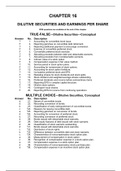
-
Test Bank Chapter 16 Dilutive Securities and Earnings Per Share.
- Answers • 53 pages • 2020
-
- $14.49
- + learn more
CHAPTER 16 DILUTIVE SECURITIES AND EARNINGS PER SHARE IFRS questions are available at the end of this chapter. TRUE-FALSE—Dilutive Securities—Conceptual Answer No. Description T 1. Accounting for convertible bond issue. F 2. Reporting gain/loss on convertible debt retirement. T 3. Reporting additional payment to encourage conversion. F 4. Exercise of convertible preferred stock. F 5. Convertible preferred stock exercise. T 6. Allocating proceeds between debt and detachable wa...
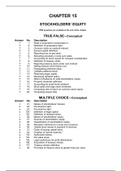
-
Test Bank Chapter 15 Stockholders' Equity.
- Answers • 50 pages • 2020
-
- $14.49
- + learn more
CHAPTER 15 STOCKHOLDERS’ EQUITY IFRS questions are available at the end of this chapter. TRUE-FALSE—Conceptual Answer No. Description T 1. State a corporation incorporates in. F 2. Definition of preemptive right. T 3. Common stock as residual interest. F 4. Earned capital definition. T 5. Reporting true no-par stock. F 6. Allocating proceeds in lump sum sales. T 7. Accounting for stock issued for noncash consideration. F 8. Definition of treasury stock. F 9. Reporting treasury st...
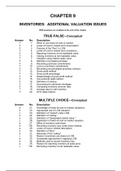
-
Test Bank Chapter 9 Inventories Additional Valuation Issues.
- Answers • 52 pages • 2020
-
- $14.49
- + learn more
CHAPTER 9 INVENTORIES: ADDITIONAL VALUATION ISSUES IFRS questions are available at the end of this chapter. TRUE-FALSE—Conceptual Answer No. Description T 1. When to use lower-of-cost-or-market. F 2. Lower-of-cost-or-market and conservatism. F 3. Purpose of the “floor” in LCM. T 4. Lower-of-cost-or-market and consistency. F 5. Reporting inventory at net realizable value. T 6. Valuing inventory at net realizable value. T 7. Valuation using relative sales value. F 8. Definition o...
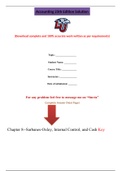
-
Chapter 8--Sarbanes-Oxley .docx
- Exam (elaborations) • 53 pages • 2020
-
- $9.49
- + learn more
Chapter 8--Sarbanes-Oxley, Internal Control, and Cash Student: ___________________________________________________________________________ 1. The Sarbanes-Oxley Act of 2002 was passed by Congress due to the public outcry after the financial scandals of the early 2000s. True False 2. Sarbanes-Oxley’s purpose is to improve financial reporting. True False 3. There are two internal control objectives and they are to ensure accurate financial reports, and ensure compliance with applicab...
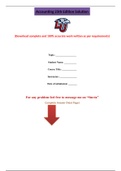
-
Chapter 22--Budgeting.docx
- Exam (elaborations) • 51 pages • 2020
-
- $2.99
- + learn more
Chapter 22--Budgeting Student: ___________________________________________________________________________ 1. A formal written statement of management's plans for the future, expressed in financial terms, is called a budget. True False 2. Budgets are normally used only by profit-making businesses. True False 3. The objectives of budgeting are (1) establishing specific goals for future operations, (2) executing plans to achieve the goals, and (3) periodically comparing actual results...

-
Chapter 23--Performance Eva.docx
- Exam (elaborations) • 43 pages • 2020
-
- $6.49
- + learn more
Chapter 23--Performance Evaluation Using Variances from Standard Costs Student: ___________________________________________________________________________ 1. A variable cost system is an accounting system where standards are set for each manufacturing cost element. True False 2. One reason not to depend solely on historical records to set standards is that there may be inefficiencies contained in past costs. True False 3. Standard costs serve as a device for measuring efficiency. T...
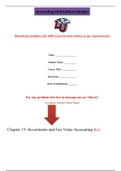
-
Chapter 15--Investments and.docx
- Exam (elaborations) • 53 pages • 2020
-
- $9.49
- + learn more
Chapter 15--Investments and Fair Value Accounting Student: ___________________________________________________________________________ 1. Although marketable securities may be retained for several years, they continue to be classified as temporary, provided they are readily marketable and can be sold for cash at any time. True False 2. As with other assets, the cost of a bond investment includes all costs related to the purchase. True False 3. If the bonds are purchased between inter...
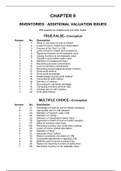
-
Test Bank Chapter 9 Inventories Additional Valuation Issues.
- Exam (elaborations) • 52 pages • 2020
-
- $19.49
- + learn more
CHAPTER 9 INVENTORIES: ADDITIONAL VALUATION ISSUES IFRS questions are available at the end of this chapter. TRUE-FALSE—Conceptual Description T 1. When to use lower-of-cost-or-market. F 2. Lower-of-cost-or-market and conservatism. F 3. Purpose of the “floor” in LCM. T 4. Lower-of-cost-or-market and consistency. F 5. Reporting inventory at net realizable value. T 6. Valuing inventory at net realizable value. T 7. Valuation using relative sales value. F 8. Definition of a basket ...

-
Chapter 10--Fixed Assets an.docx
- Exam (elaborations) • 61 pages • 2020
-
- $30.49
- + learn more
Chapter 10--Fixed Assets and Intangible Assets Student: ___________________________________________________________________________ 1. Long-lived assets that are intangible in nature, used in the operations of the business, and not held for sale in the ordinary course of business are called fixed assets. True False 2. The acquisition costs of property, plant, and equipment should include all normal, reasonable and necessary costs to get the asset in place and ready for use. True False ...

$6.50 for your textbook summary multiplied by 100 fellow students... Do the math: that's a lot of money! Don't be a thief of your own wallet and start uploading yours now. Discover all about earning on Stuvia


